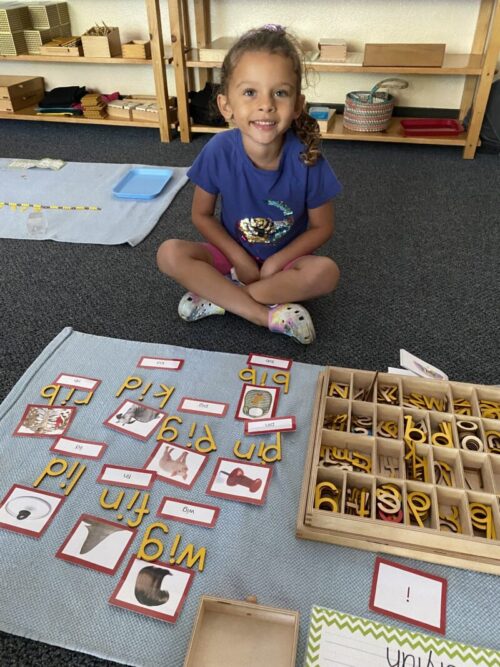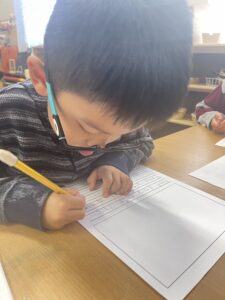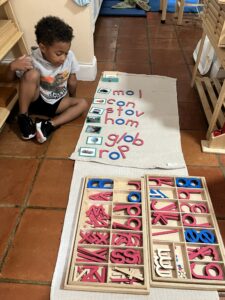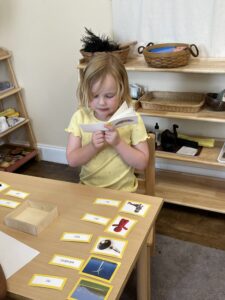
The Montessori Language Program is so rich and comprehensive that it is difficult to explain in depth in this short blog. Please see the various photos with short explanations of each work the students complete as they move through the reading, writing and grammar Montessori Language Program.
The 3- and 4-year-olds begin working with phonetic word building once they know the sounds. This leads to the blending of words. By the time the students enter the MSOSV kindergarten program the K students are building sentences. At the same time the 3- and 4-year-olds are busy with practical life, building the skills to hold a pencil as well as developing the concentration habits needed for this Kindergarten language work.


The Waseca program uses a four-step approach: after the students have been introduced to the phonetic element, the student uses the movable alphabet to spell, or encode, the word depicted on a picture card. Next, the student decodes the phonetic information by matching a picture card to its label. Then the student further practices decoding by reading the phonogram booklet and doing writing practice.
The cards use photo images to illustrate each word and large print that highlights the phonetic element used in the word. The frame around the picture and the highlighting are color-coded for the nine different boxes.
Both print and cursive are introduced.
As a supplement to the hands-on work the students complete during the daily work period there is a workbook that provides even more practice for each drawer and supports the student in working independently. A list of sight words for each drawer prepares the child to read sentences. This combined phonetic and sight-word approach assures success!
 Maria Montessori’s use of the term, ‘The Mathematical Mind,’ refers to the unique tendencies of the human mind, such as order, exactness, exploration, and orientation. Humans also have the unique abilities to imagine, create, and think abstractly. Montessori designed her math materials to incorporate the natural capabilities of a child’s mathematical mind.
Maria Montessori’s use of the term, ‘The Mathematical Mind,’ refers to the unique tendencies of the human mind, such as order, exactness, exploration, and orientation. Humans also have the unique abilities to imagine, create, and think abstractly. Montessori designed her math materials to incorporate the natural capabilities of a child’s mathematical mind.
All children have mathematical tendencies, and all children should be able to enjoy mathematical studies. Dr. Montessori proposed that the introduction of mathematics during the period of the absorbent mind (0-6 years) enables the child to form positive associations with numbers, which can be carried on throughout life. The key is to provide the child with hands-on experiences. For the young child, an explanation is not enough. Dr. Montessori wrote: “Education is a natural process carried out by the child and is not acquired by listening to words but by experiences in the environment.” Montessori demonstrated that if a child has access to concrete mathematical materials in his early years, she can come to her own understanding of abstraction concerning the concept. On the other hand, these same skills and facts may require long hours of laborious work if introduced later in abstract forms or simply asked to memorize.
While discussing the Montessori Language Curriculum for the 3rd year, let’s briefly discuss the Planes of Development. The Montessori 3rd year students are at the end of the 1st plane is Birth to age 6. The 2nd Plane of Development is children ages 6-12 years. This 2nd Plane is filled with creativity and imagination. The Montessori 3rd year student (kindergartener) is headed toward this very different time in their lives. It is the job of the Montessori Guide to prepare the kindergarten student for this next phase of development. The Montessori kindergarten students enter this 2nd plane with all the skills necessary to take off with their creativity as well as imagination.
It is only in the Montessori classroom where you will find the 3rd year students writing in cursive, in full sentences with punctuation. These students have had grammar lessons with concrete materials, they are able to move to this very abstract concept of beginning to understand and implement the different rules of writing.
To take a deeper look into the Waseca Reading and Biome Curriculum.
Stay tuned, included in this Kindergarten Series, we will be presenting the work the students do as they transition from Geography with political boundaries to Geography as Biomes with the Waseca Biomes Curriculum: Temperate Forest, Tropical Forest, Wetlands, Grasslands, Mountains, Deserts, Polar Regions, and Ocean.